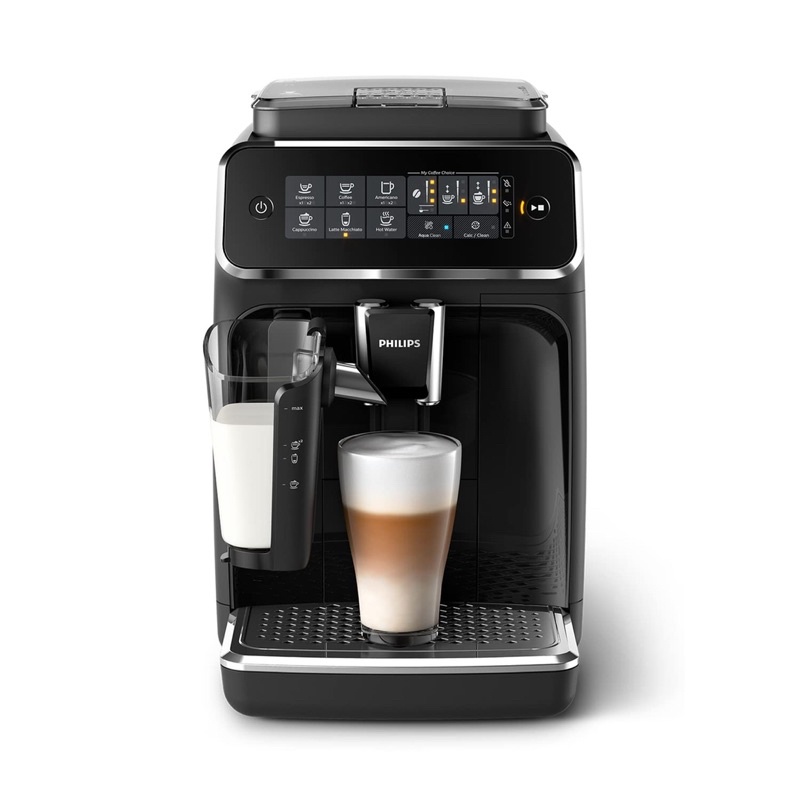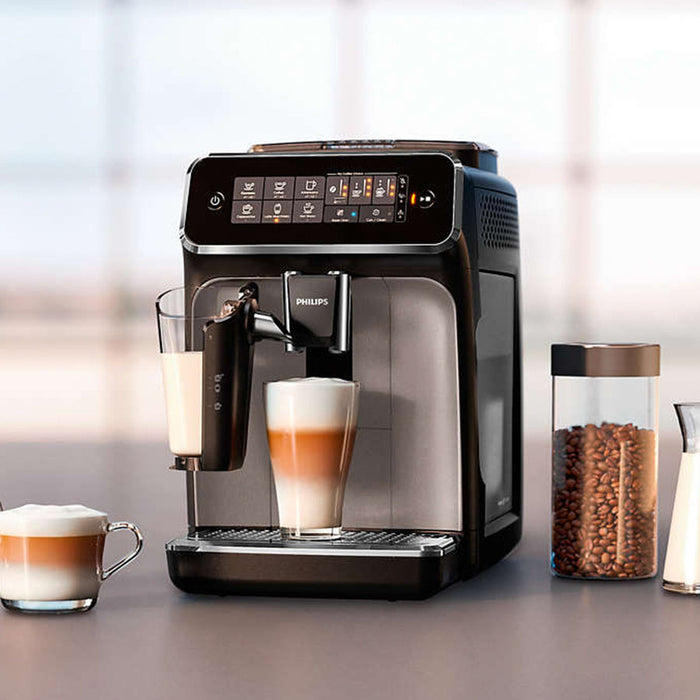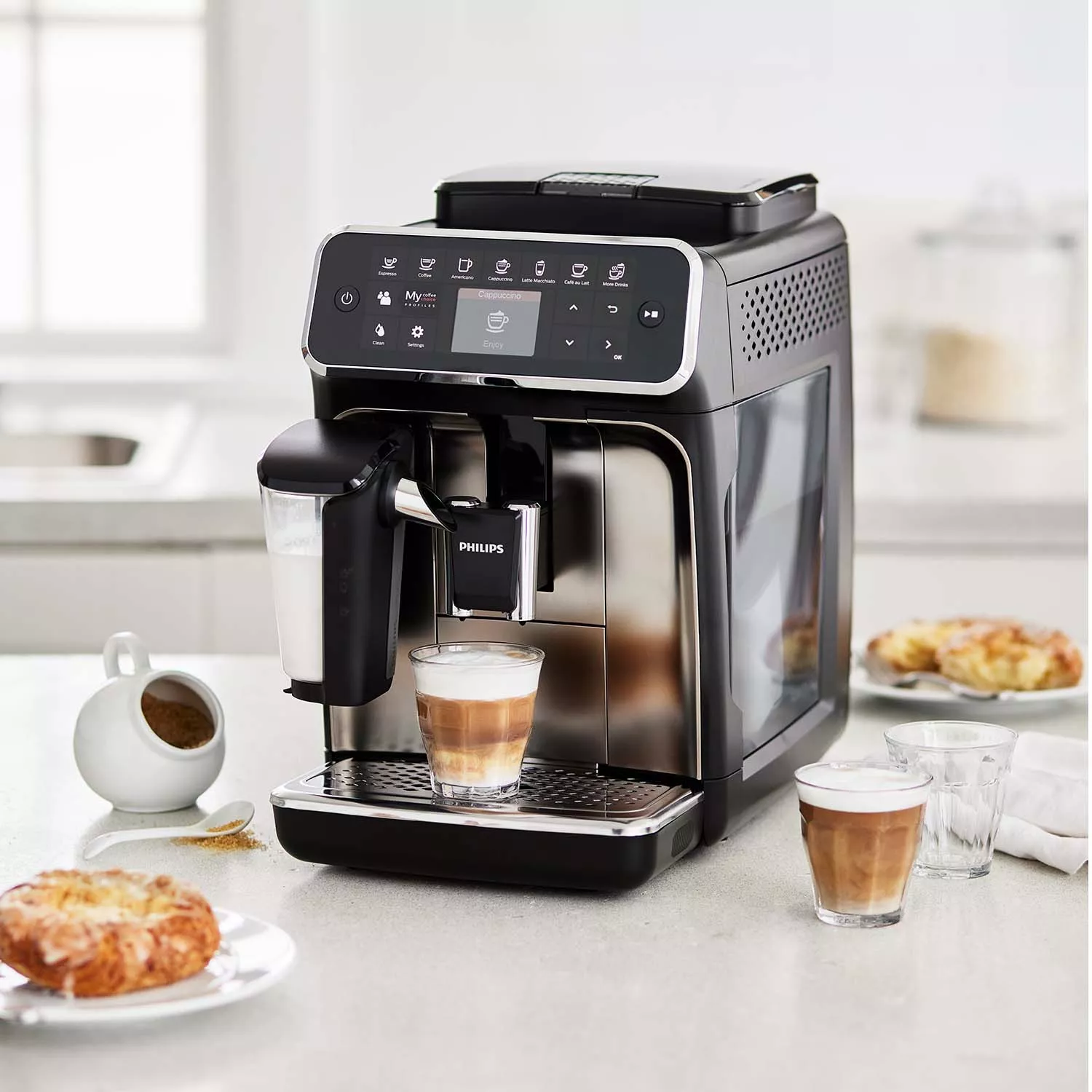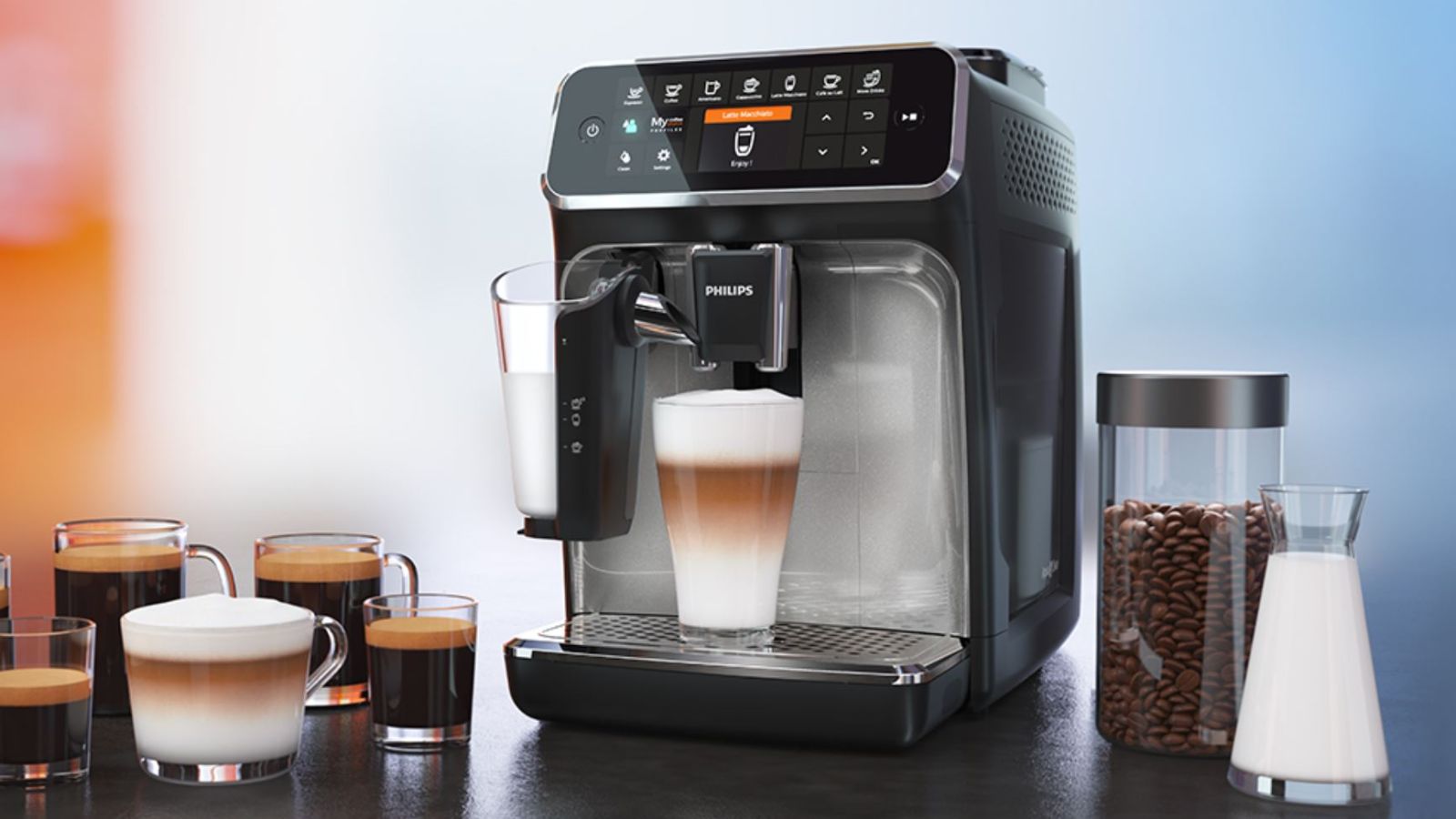#1 Philips 3200

- Easy to use and navigate
- Affordable
- Compact design
#2 Philips 4300

- Wide variety of drinks
- Intuitive touchscreen
- Compact with milk frothe
#3 Philips 5400

- Wide variety of drinks
- Advanced customization
- User profiles
As someone who genuinely appreciates a good cup of coffee, I’ve always been on the lookout for a machine that can combine ease of use, versatility, and quality in one package. When I started exploring the Philips 3200, 4300, and 5400 series, I realized just how far home espresso machines have come. These three models offer a range of features for different needs, and having personally tried them, I want to share my insights. If you're trying to decide between them, this guide will give you an in-depth look at what each has to offer and why the Philips 5400 might be worth considering.

Philips 3200 vs 4300 vs 5400: Who Are They For?
Each machine in the Philips lineup caters to a slightly different type of coffee drinker. The Philips 3200 series is great for beginners or those who just want to push a button and enjoy a reliable espresso or cappuccino. Its simplicity is a significant advantage for people who don’t want to fuss with too many options.
The Philips 4300 series, on the other hand, steps up the game with additional features like more drink choices and user profiles. This is a great option for smaller households or those who want a bit more variety in their coffee routine.
Finally, the Philips 5400 series is for those who love to experiment with their coffee and appreciate having options. With its larger range of drinks, advanced customization, and the ability to save multiple profiles, it’s perfect for coffee enthusiasts or households with diverse tastes.
My First Impressions of the Philips 5400
When I first unboxed the Philips 5400, I was impressed by its sleek design and intuitive touchscreen interface. Setting it up was surprisingly simple, with clear instructions guiding me through the initial setup. The LatteGo milk system, which snaps together without small or tricky components, immediately caught my attention as a feature that would save time and frustration. I’ve used other machines with more complex milk frothing systems, and none have been as easy to clean as this one.
Ease of Use: A Shared Strength Across the Lineup
One thing I’ve consistently appreciated about all three models is how user-friendly they are. Whether you’re using the Philips 3200, 4300, or 5400, the interface is straightforward, and the machines guide you through each step, from grinding the beans to pouring the perfect cup.
With the Philips 5400, I found the learning curve to be almost non-existent. The vibrant touchscreen allows you to select your preferred drink with a simple tap. Adjusting the strength, volume, and temperature of your coffee is intuitive, even if you’re not a coffee expert.
For comparison, while the 3200 series lacks the touchscreen and offers fewer drinks, it maintains the same level of simplicity. The 4300 series strikes a balance, with a button-based interface that’s easy to navigate and access to slightly more options.
The LatteGo System: A Game-Changer for Milk Lovers
If you enjoy cappuccinos, lattes, or flat whites, the LatteGo system is worth highlighting. Unlike traditional milk frothing wands that require more precision and cleaning, the LatteGo system is as straightforward as it gets. You simply fill the milk container, attach it to the machine, and it does the rest.
I’ve used the LatteGo system across all three models, and the results are consistently impressive. The milk froth is creamy, smooth, and perfectly heated. After use, it’s easy to disassemble and rinse, which is a huge time-saver compared to other machines I’ve tried. For anyone who prioritizes convenience, this system is a standout feature.
Performance and Coffee Quality
All three machines deliver high-quality coffee, but the Philips 5400 consistently impressed me with its versatility. I’ve tested espresso, cappuccinos, americanos, and more niche drinks like flat whites and ristrettos, and each one felt tailored to my preferences.
The ceramic grinders in all three models are a big selling point. They’re durable and ensure that the coffee is ground evenly, which directly impacts the flavor. With 12 grind settings available, it’s easy to adjust the machine to suit different bean types and roast levels.
One feature unique to the 5400 series is the ability to adjust the "Extra Shot" function. I use this frequently when I need a stronger, more robust coffee, especially during busy mornings. While the 3200 and 4300 series still deliver excellent coffee, they lack this level of customization, which may be a deciding factor for some.
Cleaning and Maintenance
No one wants a machine that’s a hassle to maintain, and Philips has made it a priority to keep things simple. All three models feature the AquaClean filter, which minimizes descaling by allowing up to 5,000 cups before maintenance is needed.
The LatteGo system deserves another mention here for how easy it is to clean. I’ve owned machines where cleaning the milk frother was so cumbersome that I stopped using it altogether. With the Philips 5400, rinsing the LatteGo components takes just seconds.
What I Loved About the Philips 5400 (and a Few Minor Gripes)
After using the Philips 5400, it’s clear that it’s designed for people who value both quality and convenience. Here are some standout features I appreciated:
- Custom Profiles: With four user profiles, I could save my preferred settings without affecting other users. This is a huge plus in a multi-person household.
- Drink Variety: Having 12 drinks at my fingertips kept my coffee routine exciting. I found myself experimenting with drinks I hadn’t previously considered.
- Touchscreen Interface: The intuitive controls made every step of the process seamless.
That said, the machine isn’t without its limitations. For one, it’s larger than the 3200 and 4300 models, so it requires more counter space. Additionally, the upfront cost is higher, which might not appeal to those with simpler coffee needs.
When to Choose the Philips 3200 or 4300
While I love the Philips 5400, I understand it’s not the best choice for everyone. If you’re just starting out with a super-automatic espresso machine, the Philips 3200 is a great entry point. It’s reliable, straightforward, and offers the essential coffee drinks without overwhelming you with options.
The Philips 4300 strikes a good balance between affordability and versatility. With additional drinks and user profiles, it’s ideal for those who want a little more flexibility without splurging on the top-tier model.

Product Review Conclusion: Philips 3200 vs 4300 vs 5400
At the end of the day, the right machine depends on your preferences and lifestyle. The Philips 3200 excels in simplicity, the Philips 4300 offers solid versatility, and the Philips 5400 shines as the ultimate option for those who want it all.
Having used all three machines, my recommendation leans towards the Philips 5400 for its comprehensive feature set and ability to cater to a wide range of coffee preferences. Whether you’re hosting friends, making coffee for a family, or indulging in a solo cup, this machine delivers consistent quality and convenience that’s hard to beat.

Frequently Asked Questions: Philips 3200 vs 4300 vs 5400
Q: What is the main difference between the Philips 3200, 4300, and 5400 models?
A: The primary difference between these models lies in the range of drinks, customization options, and user profiles. The Philips 3200 is the most basic option with fewer drink choices, while the Philips 4300 introduces more beverage options and supports two user profiles. The Philips 5400 stands out with 12 drink options, 4 user profiles, and advanced customization features, including the "Extra Shot" function for a more robust coffee experience.
Q: Is the Philips 5400 worth the extra cost?
A: For coffee enthusiasts or households with multiple coffee drinkers, the Philips 5400 is a worthwhile investment. The extra cost is justified by its versatility, larger drink variety, customizable settings, and the convenience of the LatteGo milk system. If you’re looking for a machine that caters to diverse tastes and offers higher flexibility, the 5400 series is a solid choice. However, if you only need basic coffee drinks, the 3200 or 4300 models may suffice.
Q: How easy is it to clean the Philips 5400?
A: Cleaning the Philips 5400 is one of its standout features. The LatteGo milk system is easy to disassemble and rinse after use, and the machine has an automatic cleaning cycle that ensures the internal components stay in good condition. Additionally, the AquaClean filter reduces the need for descaling, allowing for up to 5,000 cups before maintenance is required. Overall, cleaning is simple and user-friendly.
Q: Can I adjust the strength of the coffee on all three models?
A: Yes, all three models—3200, 4300, and 5400—allow you to adjust the strength of your coffee. However, the Philips 5400 offers more detailed customization options, letting you fine-tune the strength, volume, and temperature more precisely for each type of drink. The 4300 also provides some flexibility in this regard, while the 3200 offers basic strength adjustments.
Q: What types of coffee drinks can I make with the Philips 5400?
A: The Philips 5400 offers an impressive range of 12 drink options, including espresso, cappuccino, latte macchiato, flat white, ristretto, americano, and many more. It also includes more customizable features, such as adjusting the coffee strength and milk frothing to suit your preferences. Whether you're a fan of espresso or enjoy milk-based drinks, the 5400 series has you covered.
Q: Does the Philips 5400 support multiple user profiles?
A: Yes, the Philips 5400 can save up to 4 user profiles. This means that you can save your preferred settings for each user, such as coffee strength, temperature, and milk frothing preferences, ensuring that everyone in your household can easily enjoy their ideal cup of coffee without having to adjust the machine every time.
Q: How much counter space does the Philips 5400 take up?
A: The Philips 5400 is larger than the 3200 and 4300 models, so it requires more counter space. However, it’s still designed to fit comfortably in most kitchens. If space is a concern, you might want to consider the 3200 or 4300, which are more compact and ideal for smaller kitchens or countertops.
Q: How long does it take to brew a cup of coffee?
A: Brewing times are relatively quick for all three models. Generally, it takes about 30-60 seconds for the machine to brew an espresso, and about 1-2 minutes for more complex drinks like cappuccinos or lattes, especially when milk frothing is involved. The Philips 5400 has an efficient brewing process, and the LatteGo system ensures that the milk froths quickly.
Q: Can I make a strong cup of coffee with the Philips 3200?
A: Yes, the Philips 3200 can brew a strong cup of coffee, though it lacks the "Extra Shot" function found in the 5400. You can adjust the strength of the coffee to suit your taste, but if you prefer extra strength or a more specialized cup, the 4300 or 5400 might be better suited for your needs due to their enhanced customization options.
